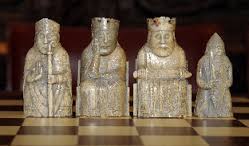![]()
A set of medieval chess pieces dating back to the late 12th century has been revealed
by VisitScotland as one of the top 25 objects to have shaped Scotland’s history in
a stunning new e-
The Lewis Chessmen which feature at number nine on the date ordered list, are between 3.5cm and 10.2cm high. Most are carved from walrus tusk, but a few are made from a whale’s tooth. They were found in 1831 in a small stone kist in a sand dune in Uig on Lewis.
The original hoard -
Compiled by an expert panel for the 2017 Year of History, Heritage and Archaeology, the 25 objects cover over 5,000 years of Scottish history and the length and breadth of the country from Shetland to Dumfries.
The objects were chosen based on chronological and geographic spread alongside their individual interesting stories.
The final 25 were chosen by a panel that included representatives from Historic Environment Scotland, National Museums of Scotland, Society of Antiquaries of Scotland and VisitScotland.
Other items appearing in the list include a Roman distance slab, a medieval football, Antarctic goggles, a carved footprint and a dancing fiddle.
VisitScotland hopes that visitors will go on a trail this summer to discover as many of the objects as possible and in turn discover more about Scotland’s fascinating past.
The oldest object in the list is a barbed harpoon point (originally found in the Macarthur Cave, Oban) that dates back to the Middle Stone Age, and is one of the earliest instruments used to hunt and fish in Scotland.
The most modern in the list is Dolly the Sheep -
More unusual objects on the list include the Orkney Venus – the earliest known depiction
of the female human form -
A violin which ignited Robert Burns’ rebellious streak, revealing more about the great Bard’s personality is another object that makes the final cut. The Gregg Violin was owned by Burns’ dance teacher, William Gregg.
Uig Chessmen one of ‘25 objects that shaped Scotland’s history’
5 August 2017
